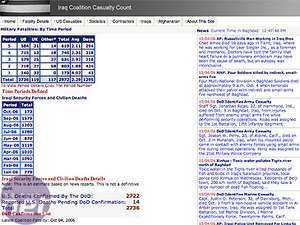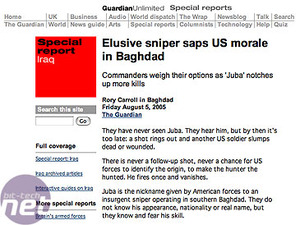Part 2 – The View From Iraq; Juba, Fallujah and Amarillo
The War On Terror, barring the occasional terrorist outrage and missile strike, could have run its course very quietly and inexpensively were it not for Iraq. It is not for us to judge the decisions that brought this war about, but it does provide the first clear case of a war that for the first time is being brought to the online world in a way never before envisaged.One of the classic examples of how the Iraq war has become so intricately linked to the internet is by way of the news. Not just the constant around the clock reporting of news; that has been with us since the first Gulf War of 1991. What we see now is not just the reporting from the BBC, CNN and other news networks, we are also seeing information being collated online to bring us a more complete view of events.


The BBC provides 24-hour coverage, and the ICCC aggregates information.
The ability to get a much more reliable stream of information from the front line is new and unusual, and clearly not something that would sit well with military traditionalists who know the value of keeping casualties and other bad news quiet. But the capacity to bring war directly from the front line to the internet can also be used to misinform.
The myth of Juba
Juba is an alias used by, well, nobody really knows who. According to the video made to honour him and the rumours that have abounded, Juba is an anonymous sniper who picks off American soldiers with a single shot, then vanishes. The use of a single shot is nothing to do with the glamorous sniping credo ‘One shot, one kill’, it is simply that any follow up shot at all draws attention to the firer’s location.
The modus operandi adopted by Juba however is not particularly unique, especially amongst trained military snipers, leading many to believe that the mysterious Juba is in reality just a name attached to the collective efforts of several former Iraqi army sharpshooters. One thing that cannot be denied, though, is that somebody was picking off US troops with unnerving accuracy, hitting them where their armour did not cover, and videoing these killings for the internet. Despite little concrete evidence to prove his existence one way or another Juba the sniper did manage to rack up column inches in the press, proving that the popularity of military villains like the Red Baron hasn’t diminished over the years.


Does Juba exist, and is he an AWP whore?
If the sniper captured that day was Juba, the insurgents talismanic killer, then to use this as a public relations victory the US army would first have to admit that this one man had killed dozens of their soldiers; but if they didn’t embrace the myth there could be little glory in defeating this enemy. In the end the capture, or not as it may be, of Juba was left as a obscure footnote and the myth is quietly being allowed to drop. Whether sniper attacks in Baghdad are still going on and still being attributed to Juba is almost impossible to know for sure but what is certain is that it’s much harder to kill a myth than a man, especially in the days of the internet.

MSI MPG Velox 100R Chassis Review
October 14 2021 | 15:04







Want to comment? Please log in.